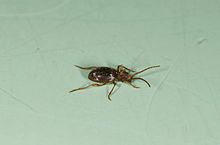
Dermestidae are a family of Coleoptera that are commonly referred to as skin beetles. Other common names include larder beetle, hide or leather beetles, carpet beetles, and khapra beetles. There are over 1,800 species described.

The khapra beetle, also called cabinet beetle, which originated in South Asia, is one of the world's most destructive pests of grain products and seeds. It is considered one of the 100 worst invasive species in the world. Infestations are difficult to control because of the insect's ability to survive without food for long periods, its preference for dry conditions and low-moisture food, and its resistance to many insecticides. There is a federal quarantine restricting the importation of rice into the U.S. from countries with known infestations of the beetle. Khapra beetle infestation can spoil otherwise valuable trade goods and threaten significant economic losses if introduced to a new area. Handling or consuming contaminated grain and seed products can lead to health issues such as skin irritation and gastrointestinal distress.

Spider beetles make up the subfamily Ptininae, in the family Ptinidae. There are approximately 70 genera and 600 species in the subfamily, with about 12 genera and 70 species in North America north of Mexico.

Ptinidae is a family of beetles in the superfamily Bostrichoidea. There are at least 220 genera and 2,200 described species in Ptinidae worldwide. The family includes spider beetles and deathwatch beetles.
Home-stored product entomology is the study of insects that infest foodstuffs stored in the home. It deals with the prevention, detection and eradication of pests.

Mezium americanum, the American spider beetle or black spider beetle, is a species of beetle in the subfamily Ptininae, the spider beetles. These are sometimes mistaken for spiders or mites because of their rounded abdomens and long legs. It has a cosmopolitan distribution, but it is an exotic species in Australia.
Ptinus clavipes is a species of spider beetle in the family Ptinidae.

Ptinus fur, the white marked spider beetle, is a species of spider beetle in the genus Ptinus, with a nearly cosmopolitan distribution.
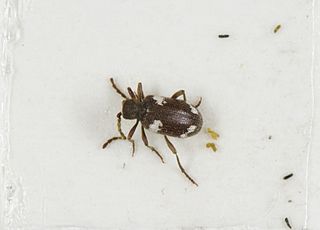
Ptinus sexpunctatus is a species of beetles in the genus Ptinus of the family Ptinidae. It is commonly known as the six-spotted spider beetle.
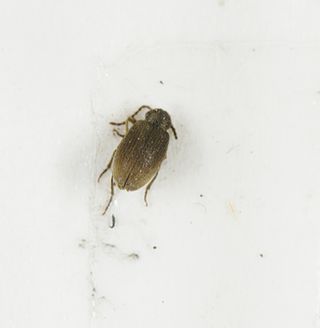
Ptinus tectus, often called the Australian spider beetle, is a species of beetle in the family Ptinidae, or family Anobiidae, subfamily Ptininae. It is a cosmopolitan species. It is a pest of stored foods and museum specimens.
Ptinus raptor, the eastern spider beetle, is a species of spider beetle in the family Ptinidae.
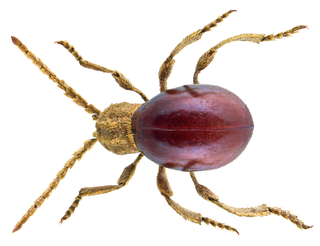
Mezium affine is a species of beetle in the family Ptinidae. Its common names include shiny spider beetle, northern spider beetle, and hood spider beetle. It occurs throughout the Northern Hemisphere, and it is an introduced species in Australia.
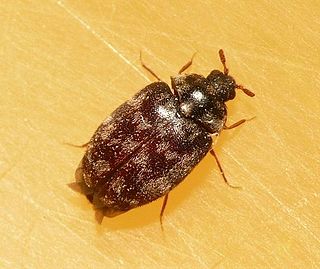
Anthrenocerus australis is a species of beetle belonging to the Dermestidae family. It is commonly known as the Australian carpet beetle and is one of the most researched of the thirty-one species in the Anthrenocerus genus. This is generally attributed to its prevalence throughout Australia and New Zealand and the negative economic and agricultural impact it has as a pest. It is the larvae that causes damage to products, not the adult beetle. The total life cycle of this insect is around three years, most of which is spent as a larva. Once the beetle reaches maturity, it only lives for between two and six weeks.
Ptinus tumidus is a species of spider beetle in the family Ptinidae. It is found in North America.
Ptinus paulonotatus is a species of spider beetle in the family Ptinidae. It is found in Central America and North America.
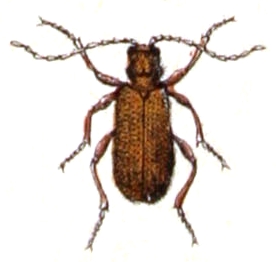
Ptinus latro, the brown spider beetle, is a species of spider beetle in the family Ptinidae. It is found in Africa, Europe and Northern Asia, North America, and Southern Asia.
Ptinus hystrix is a species of spider beetle in the family Ptinidae. It is found in North America.
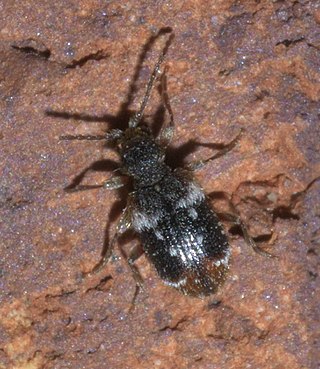
Ptinus bimaculatus is a species of spider beetle in the family Ptinidae. It is found in North America.
Ptinus caelebs is a species of spider beetle in the family Ptinidae. It is found in North America.
